|
Journal |
The valley of Passargadae
The birthplace of Persian Empire |
|
Series:
Visual Essays Author:
Jamshid Varza
Related Links:
Tribute Bearers of Persepolis...
Novruz in Persepolis..
Achaemenian Jewel...
The First Declaration of Human Rights...
|
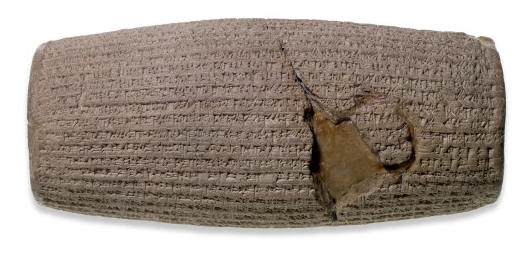
The First Declaration
of Human Rights by Cyrus the Great,
The founder of Persian Empire, 532 BCE
Cuneiform clay tablet known as Cylinder of Cyrus,
uncovered in temple of Marduk in Babylon, currently in British Museum
(see article) |
|
|
The ancient province of
Pars in central Iran is known for being the home of
sites of immense importance in the history of
the ancient world. When traveling from Shiraz, the fabled
capital of Pars,
toward Esfahan the second largest city in Iran, the traveler enters a road
that takes him to the valley of Passargadae. |
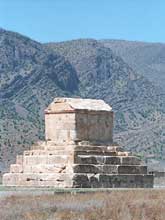
Tomb of Cyrus |
Welcome to Paradise
Persians gave the world the word "Paradise," or "Pardis" in Farsi, or "Ferdows"
in Arabic which all are forms of "Paradeisis" in ancient Persian meaning enclosure or a walled garden. It implies the enclosed garden
surrounding the palace of Cyrus the Great.
Perhaps there were
reasons for "Paradaeisis" to become the metaphor for heaven "the abode of
light" in prominent world religions. Cyrus as a Zoroastrian emperor was
mentioned by the ancient historian Herodotus for his kindness equally
toward friends and defeated enemies.
The scholar Mary Boyce states "of all ancient Persian leaders
Cyrus' manners were the most compatible with his Zoroastrian beliefs." |
|
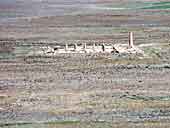
Palace of Audience (P)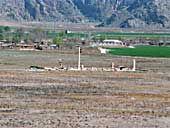
Residential Palace (S) |
Cyrus in his lifetime built the world's first
empire which treated all its subjects as equal. The Persian Empire spanned
many nations, cultures and religions in a land mass
stretching
from India to
Greece, and central Asia to Egypt. No other leader prior to Cyrus had faced
the challenge of running such a vast empire.
There are a number of references to Cyrus the Great in the Old Testament.
Cyrus is referred as the LORD's shepherd and the "anointed one:"
Book of Isaiah 45:1 -- "Thus says the LORD to his anointed, to Cyrus, whose right
hand I have grasped to subdue nations before him..."
Book of Ezra 1:1 -- "In the first year of King Cyrus of Persia, in order that
the word of the LORD by the mouth of Jeremiah might be accompanied, the LORD
stirred up the spirit of king Cyrus of Persia so that he sent a herald
throughout all his kingdom, and also in a written edict declared: "Thus says
king Cyrus of Persia: The LORD, the God of heaven, has given me all the
kingdom of the earth, and he has charged me to build him a house at
Jerusalem in Judah. Any of those among you who are of his people -- may
their God be with them..." |
|
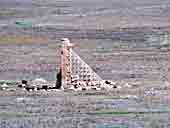
Zoroastrian Fire Temple |
A Cuneiform clay tablet known as Cylinder of Cyrus
provides us with a detailed account of Cyrus after his conquest of Babylon.
He treat his new subjects with kindness, orders his troops to protect them
and avoid any mistreatments. Cyrus restores the temples left in ruins and
rebuilds the walls of Babylon. Archeologist Rassam uncovers the Cylinder
during an excavation dating 1879 AD in temple of Marduk. It is considered a
fortification tablet produced by Babylonian priests, the conquered subjects
who mention Cyrus as their protector.
This Cylinder states that Cyrus
freed the Jewish people from captivity and slavery in Babylon to return home and
rebuild their temple. |
|
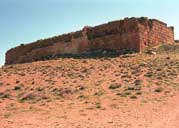
Soldier Guard Compound
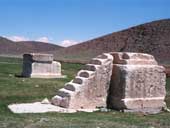
Zoroastrian Fire Altar |
Passargadae, the first Achaemenian capital
The father of history, Herodotus, who lived in Asia minor under Persian rule
gives the account of Cyrus' birth and childhood. Cyrus was the son of Cambysis,
ruler of the small kingdom of Persia and Mandanes, the daughter of
Astyages, the last Median king.
By his talent and leadership Cyrus lead the small army of Persians to fight
the larger army of Medians. Herodotus tells us the leaders of the two armies
choose not to fight. Instead they joined their forces and annexed the larger
kingdom of Media to Persia -- this was certainly the beginning point of
the Persian Empire in its long history. From there Cyrus continued to subdue
the
kingdom of Lydia in Asia minor, and kingdom of Babylonia and annexed them to
his empire. Historian Dandemaev
believes the valley of Passargadae was the place where the two armies met
and chose not to fight. From that point Cyrus went on
to build his empire.. |
|
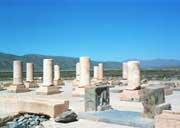
General view of Palace (P) |
The
valley of Passargadae has produced archeological artifacts dating as far
back as the third millennium BCE.
Archeologists believe it was one of the earlier places in which a Persian
tribe had settled.
Herodotus gives the name of this tribe as Passargadaens amongst several
other Persian tribes settling in the region.
Persians and Medes were the first descendents of Indo-European people who
migrated to the Iranian plateau from the southern steppes of Russia and central
Asia. Medes were the first Iranian people who entered ancient historical
records and later the Persian built the world's first empire. What history finds
remarkable is that Cyrus' empire was built on equality of all subjects. |
|
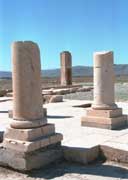
General view of Palace (P) |
An
aerial view of Passargadae valley shows ruins of the two palaces, a Zoroastrain
fire temple, two stone fire altars, a soldier guard compound, and tomb of
the Cyrus the Great. Cyrus used one palace for his private residence and one as
an audience palace.
Cyrus was killed at the age of seventy during a war near Oxus river in north
eastern frontier of his empire. He body was carried by his soldiers for over
1000 miles to his beloved valley of Passargadae.
A
trilingual cuneiform writing on a stone pillar in the palace of Audience
translates to "Cyrus the Great King, an Achaemenian." (see image below.)
|
|
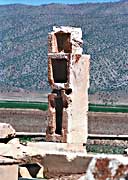 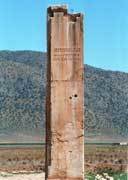 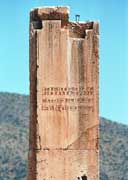 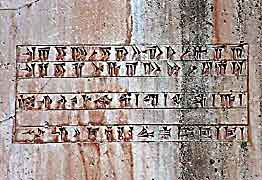
General views of Palace (P), a close up image shows a trilingual cuneiform
inscription in a Palace pillar |
|
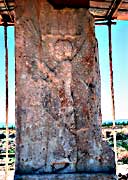
The winged genie "Cyrus" |
The
royal figure carved on a stone pillar stands on palace (S) in Passargadae.
It is believed that this figure belongs to Cyrus the Great. The figure wears
an Elamite dress, an Egyptian crown, and Assyrian wings -- all members
countries of the Persian Empire.
A
historian reports a text about the figure's head reads: Kûrush :
xshâyathiya : vazraka : Kabûjiya; hyâ : xshâyathiyahyâ : puça :
Haxâmanishiya; thâtiy : yathâ ...; ... ... akutâ ...
Cyrus the Great King, son of Cambyses the King, an Achaemenian.
He says: When ... made ... |
|
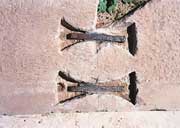
An ancient construction method |
An ancient construction method reveals itself
A closer look at the floor of this ancient palace reveals an ancient method
of joining stone slabs; a slot was carved into two slabs, a large piece of
flat metal inserted and the slot was filled with molten lead. To this
date the joints seem in place. |
|
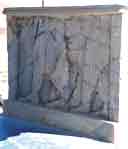
Decorative carvings in entry ways |
Remaining decorative figures in palaces show Assyrian style carvings in
entry ways. |
|
|